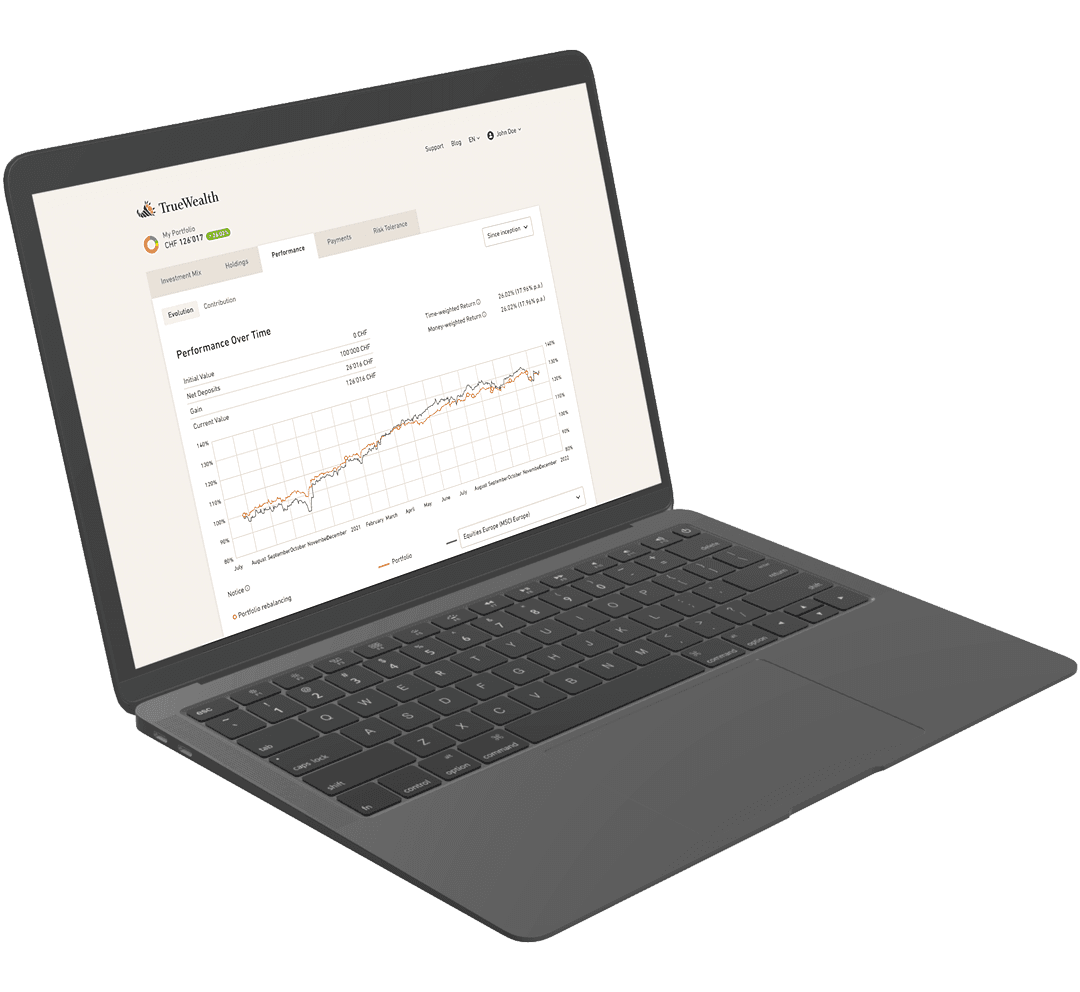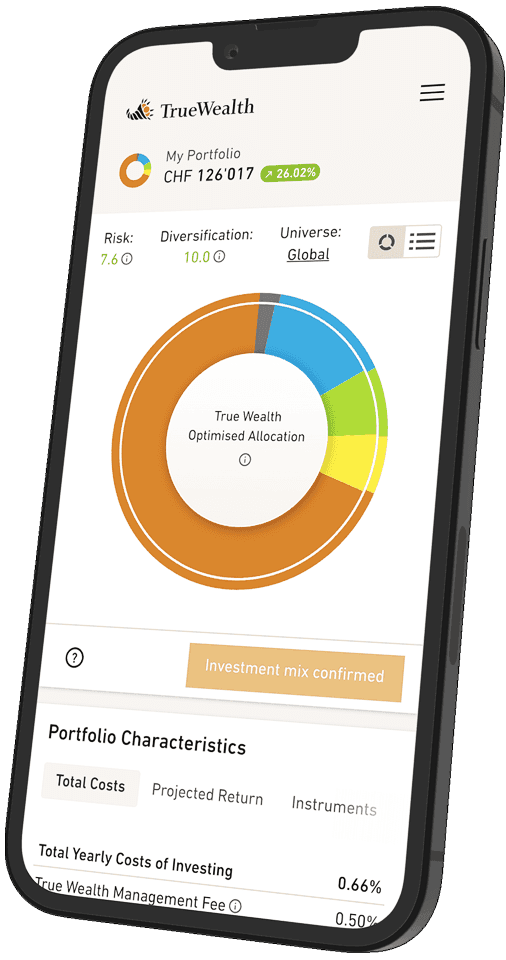#26 Improve your long-term returns with currency hedging
Currency hedging can help you improve your returns over the long term. Find out how it works, how much currency hedging makes sense and how we use currency hedging at True Wealth.
As we all know, there are no short cuts when it comes to investing: if you want to grow your wealth over the long term and prefer an attractive return to the interest on your bank account, you have to be prepared to expose your assets to the risk of fluctuations in value over a longer period of time. If someone promises you high returns without risk, you should be cautious.
Diversification is the key to any good investment strategy
A key feature of a good investment strategy is diversification. Diversification costs nothing and reduces the fluctuations in the value of your portfolio without affecting the expected return. Therefore, a good investment strategy should not only be diversified across many stocks and bonds, but also, depending on your risk tolerance, across different asset classes and industry sectors.
Global diversification entails currency risks
Ideally, your portfolio should also be invested internationally in different economic areas. However, this presents many investors with a dilemma, because a globally diversified portfolio is not only exposed to market fluctuations in individual local markets, but also to foreign currency risk.
This dilemma is particularly relevant for Swiss investors, as the Swiss equity market is concentrated in relatively few sectors such as pharmaceuticals and finance. In addition, the Swiss franc is often seen as a safe haven internationally and therefore tends to appreciate in times of crisis. At least if the crisis does not have its epicenter in Switzerland. If, for example, the next banking crisis were to originate in the case of the remaining Swiss big bank, this would also likely cause the Swiss franc to falter.
Global crises can amplify the fluctuations in the value of foreign investments for Swiss investors.
Hedging currency risks with FX hedging
The good news is that the exchange rate risk associated with holding securities in foreign currencies can be hedged by means of a so-called FX hedge (foreign exchange hedge). For example, some ETF and index funds have share classes that hedge the currency risk against the Swiss franc. This does come at a cost, however: on the one hand, the management fees for currency-hedged ETF and index funds are sometimes, but not always, slightly higher. On the other hand, currency hedging also neutralizes the interest rate difference between the Swiss franc and the interest rate level in the foreign currency. This is in the nature of things, otherwise an arbitrage opportunity would arise and one could benefit from the higher interest rates of the foreign currency without currency risk. No investor would, for example, buy bonds of the Swiss Confederation any more.
Currency hedging also compensates for the loss in value that occurs when the foreign currency loses value against the Swiss franc, especially if inflation abroad is higher than in Switzerland over a longer period of time.
Effects of FX hedging on your portfolio
Currency hedging can thus reduce the risk of fluctuations in the value of the portfolio, but it also prevents potential gains from an appreciation of foreign currencies. If you look at currency hedging in isolation, it could cost you a little return in the long term, depending on how the major currencies develop in the future.
In the context of a portfolio, however, currency hedging allows you to use your personal (and individually different) «risk budget» more efficiently. This means that currency hedging allows you to diversify your portfolio internationally and to be less limited to Swiss bonds and (sector-focused) Swiss equities.
This is particularly advantageous for investors with a low to medium risk tolerance.
On the other hand, all investors can use the risk budget freed up by currency hedging to slightly increase the proportion of investment classes with higher return potential in their investment strategy. The overall expected effect is a lower risk of fluctuation and a better long-term return.
Should you hedge currency risk or not?
Theoretical approach
You may ask: should the entire foreign currency risk be hedged? Modern portfolio theory has an interesting answer to this: with every currency fluctuation, there is a side that wins and a side that loses. However, the currency return for the winner is greater than the loss for the loser. If the exchange rate changes from 1:1 to 1:2, for example, the investor on the winning side will see a 100% gain, but the investor on the losing side will only see a 50% loss on his foreign currency holding. Due to this asymmetry, even under ideal conditions, only a portion of the foreign currency holding in a globally diversified equity portfolio should be hedged, not 100%. Under certain assumptions regarding expected returns and exchange rate risks, the optimal hedging rate for an average investor is 70-80%.
Practical approach
In reality, the implementation of currency hedging also costs something, so the optimal degree of hedging is somewhat below the theoretically recommended value. All in all, we consider a hedging level of up to 50% of the foreign currency component to be reasonable, depending on risk tolerance.
How do we handle currency hedging at True Wealth?
In the past, we only used currency-hedged investment instruments in our investment strategies for Pillar 3a. However, many ETFs and index funds now offer currency-hedged share classes with a TER that is not significantly higher than that of their non-currency-hedged counterparts. That is why we now use a mix of currency-hedged and non-currency-hedged investment instruments in our investment strategies for both Pillar 3a and discretionary asset management. To be sure, the proportion of currency-hedged investment instruments also depends on your risk tolerance. The lower (more bond-heavy) the portfolio risk, the higher the hedging rate of the foreign currency component and vice versa.
What does currency hedging actually cost?
The costs of currency hedging are low due to the high liquidity of the FX market and are generated by regularly rolling forward contracts (FX swaps) approximately every three months. The resulting bid/ask spreads of the forward contracts for the major currencies (including CHF, USD, EUR, GBP, JPY) are only a few basis points (hundredths of a percentage point).
In general, the management of a currency-hedged share class is somewhat more expensive, which is why the external product costs (TER) tend to be slightly higher than for unhedged share classes. We report the TER transparently under «Portfolio characteristics» and it amounts to 0.13% for the global model portfolio and 0.21% for the sustainable portfolio. Before the changeover, the TER was somewhat higher. This is due to the fact that we have linked the use of currency-hedged investment instruments with a comprehensive cost and liquidity review of our investment universe.
A note for the pros: As already mentioned, currency hedging also involves neutralizing the interest rate difference between the two currency areas. This is often mistakenly presented as a cost factor. However, the interest rate difference between currencies should be seen as a risk premium, because it is countered by the risk that the currency with the higher interest rate will weaken against the currency with the lower interest rate in the long term. It is therefore a classic strategy for traders and hedge funds to borrow in Swiss francs or Japanese Yen and invest the money in Australian dollars (or any other currency with a higher interest rate). This is known as the carry trade. Of course, it does not always pay off. In an internationally diversified portfolio, the carry trade occurs automatically. Currency hedging can therefore be seen as a way of neutralizing or reducing the carry trade, in order to balance the investor's «risk budget» more optimally with other risk premiums.
Can I also deactivate the currency hedging?
Yes, we don't want to patronize anyone. If you don't want any currency-hedged investment instruments in your portfolio, you will find a switch in your dashboard under «Investment preferences» that you can use to deactivate the currency hedging. Please note that deactivating the proposed currency hedging will reduce the degree of diversification of the portfolio.
What is your view on currency hedging? Please write to me by e-mail.
About the author

Founder and CEO of True Wealth. After graduating from the Swiss Federal Institute of Technology (ETH) as a physicist, Felix first spent several years in Swiss industry and then four years with a major reinsurance company in portfolio management and risk modeling.

Ready to invest?
Open accountNot sure how to start? Open a test account and upgrade to a full account later.
Open test account